The first stop up the line from Penzance, once Marazion had closed, was St Erth – junction for St Ives. Next to it was a creamery where milk from the district was gathered, and much sent to Kensington in London. The station is lower on the hillside than the main A30 road from London to the far west, and sidings either side of the line have gradually been removed since the halcyon days of the 50s when there was heavy holiday traffic funneled through the station, with empty stock being stored before going east again.
Marazion was the normal limit to my forays, but as St Erth was “walkable”, I very occasionally made it that far – though there was actually little there to interest me, and it was the pleasant walk down wooded lanes that made it enjoyable. Once a year the Sunday School Treat would have us waiting on the station between trains, and we boys would crane our necks from the footbridge for the first sight of our train; and later when at college I’d pass through the place quite frequently.
 An early standard gauge view of St Erth station showing how little the basic structure has really changed. The lamps are gas, signals are wooden and the telegraph poles have gone, but the building, shelter, bridge and platforms are the same. #####AH01-SER-VISTA-PLTFM
An early standard gauge view of St Erth station showing how little the basic structure has really changed. The lamps are gas, signals are wooden and the telegraph poles have gone, but the building, shelter, bridge and platforms are the same. #####AH01-SER-VISTA-PLTFM

Water droplets array themselves on the underside of the Running In Board at St Erth station in typical mild Cornish weather that enables tropical palms and large hydrangea bushes to flourish. The chain link fencing separates the garden from the countryside. 520831A01-SER-R_I_B-VI-_N
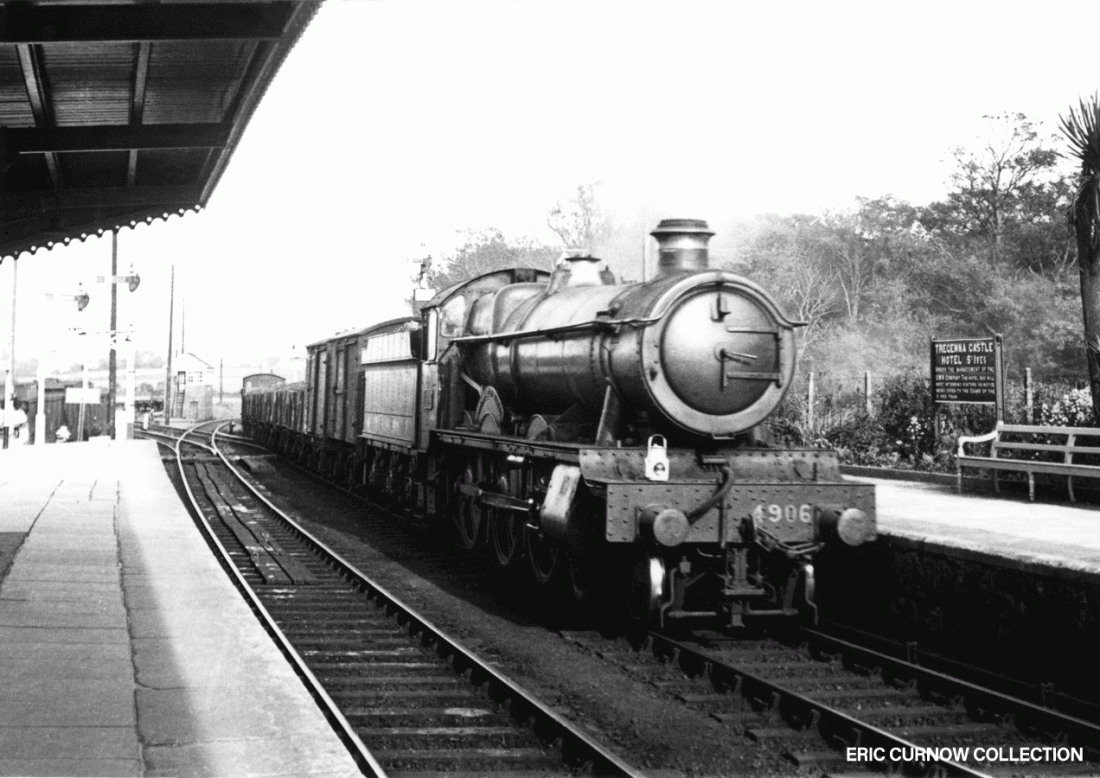
4906 “BRADFIELD HALL” runs through St Erth Station on a down freight of vans and wagons in1949. Not long after nationlisation, the engine still carries its number painted on the buffer beam, instead of raised numerals on a smokedoor plate. Platform palms and shrubs blend with the backdrop of trees. 49###AA01-STE-s4906-GDS_D

Ten years later than a similar view on this website, 1023 “COUNTY OF OXFORD” slows alongside the down platform of St Erth Station – its smokebox door carrying an ’83F’ shedplate and ‘SC’ (“Self Cleaning”) sign. The branch train awaits St Ives passengers in the bay to the left. Photo: E R Morten 570807A01-STE-s1023-PAS_D
 Its shaded livery contrasting strongly with its smokebox number, 83G (Penzance) shed plate, and red buffer beam, 4566 simmers at the stop blocks of St Erth’s bay passenger platform. Next to it is a “Toad” Brake Van, 6-plank wagon loaded with coal, and a ventilated van. 5####AM01-SER-s4566-PARKD
Its shaded livery contrasting strongly with its smokebox number, 83G (Penzance) shed plate, and red buffer beam, 4566 simmers at the stop blocks of St Erth’s bay passenger platform. Next to it is a “Toad” Brake Van, 6-plank wagon loaded with coal, and a ventilated van. 5####AM01-SER-s4566-PARKD
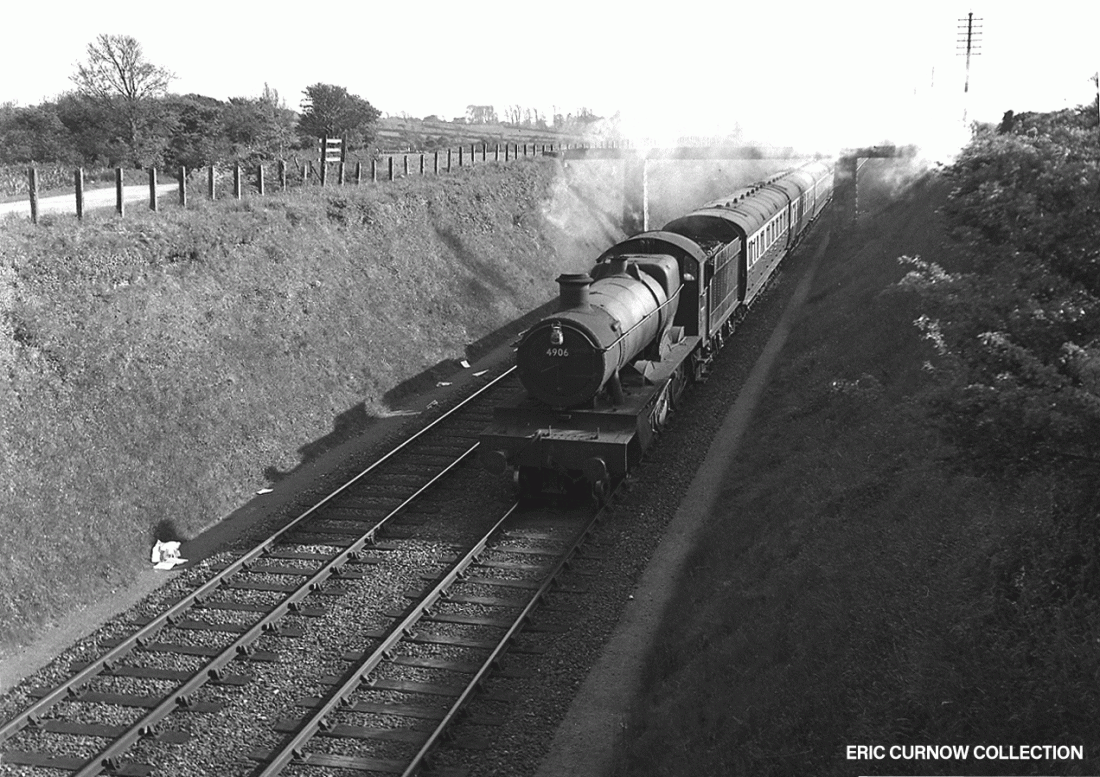
4906 crosses the watershed with a down passenger service on the main line at Canonstown near St Erth. Like many roads broken by the railway, Arch Road is now a dog’s leg over the line instead of running diagonally across it, bottom right to top left. 550524A02-SER-S4906-PAS_D
 What is probably a St Ives branch train working beyond St Erth and into Penzance passes under the leat near Arch Bridge, Canon’s Town. The carriages are in two-tone BR livery, complementing the Brunswick Green of the tank engine perfectly. 570725A01-SER-s4547-PAS_D
What is probably a St Ives branch train working beyond St Erth and into Penzance passes under the leat near Arch Bridge, Canon’s Town. The carriages are in two-tone BR livery, complementing the Brunswick Green of the tank engine perfectly. 570725A01-SER-s4547-PAS_D
 7031 “CROMWELL’S CASTLE” draws up with an eastbound freight at a deserted St Erth station. A clear open vista south was still possible when this photo was taken through ranch-style fencing to the woods and trees beyond. 6####FU01-SER-s7031-PAS_U
7031 “CROMWELL’S CASTLE” draws up with an eastbound freight at a deserted St Erth station. A clear open vista south was still possible when this photo was taken through ranch-style fencing to the woods and trees beyond. 6####FU01-SER-s7031-PAS_U
 6911 ‘HOLKER HALL’ waits by the foot crossing at the eastern end of St Erth Station with an up passenger train composed of ex-GWR wooden-bodied carriages. An ornate double lamppost and fence separates the branch platform from the main line. 570725A01-SER-s4547-PAS_D
6911 ‘HOLKER HALL’ waits by the foot crossing at the eastern end of St Erth Station with an up passenger train composed of ex-GWR wooden-bodied carriages. An ornate double lamppost and fence separates the branch platform from the main line. 570725A01-SER-s4547-PAS_D
 6938 “CORNDEAN HALL” slows with its “Up” train to come alongside Platform 2 of St Erth Station. A ”GENTLEMEN’ sign is among the signs suspended from the platform awnings, and a ‘3 CAR’ stopping point on the down main platform. 62###AG01-SER-s6938-PAS_U
6938 “CORNDEAN HALL” slows with its “Up” train to come alongside Platform 2 of St Erth Station. A ”GENTLEMEN’ sign is among the signs suspended from the platform awnings, and a ‘3 CAR’ stopping point on the down main platform. 62###AG01-SER-s6938-PAS_U

6991 “ACTON BURNELL HALL” enters St Erth Station from the east with a train of maroon coaches on a cloudless Summer’s day, between a 45XX tank headed St Ives branch train on the left and down refuge sidings on the right. Such sidings were sometimes used to store stock that could not be accommodated in the Penzance area, some 4 miles distant. 6####IM01-STE-s6991-PAS_D
 To get into the picture, the Second Man cranes his neck from the cab of D806 “CAMBRIAN’ as the Cornish Riviera heads away from St Erth in June 1960. Pride in the appearance of the new motive power seems to have already dimmed somewhat! 600627A01-SER–D806-PAS_U
To get into the picture, the Second Man cranes his neck from the cab of D806 “CAMBRIAN’ as the Cornish Riviera heads away from St Erth in June 1960. Pride in the appearance of the new motive power seems to have already dimmed somewhat! 600627A01-SER–D806-PAS_U
 Although rain isn’t actually falling, on a wet day, 807, with a nameplate on the unseen side only, slips away from St Erth apparently shunting milk tanks in 1971. The drizzle is sufficiently light to reveal another line of tanks in the yard divided around a brake van. 71###AB02-SER–d807-MIL_U
Although rain isn’t actually falling, on a wet day, 807, with a nameplate on the unseen side only, slips away from St Erth apparently shunting milk tanks in 1971. The drizzle is sufficiently light to reveal another line of tanks in the yard divided around a brake van. 71###AB02-SER–d807-MIL_U
 This rather substantial granite building is to the north of the main through line shown at the right. The bay is the other side of it, and ‘up’ sidings to its left. There was always a “homely” feel to this place, particularly internally, but also in the Station environs. 740919A01-SER-S_YRD-VIS_S
This rather substantial granite building is to the north of the main through line shown at the right. The bay is the other side of it, and ‘up’ sidings to its left. There was always a “homely” feel to this place, particularly internally, but also in the Station environs. 740919A01-SER-S_YRD-VIS_S
 3-car DMU set P555, wearing inter city livery and with a low 4-digit headcode, awaits departure for St Ives in the bay platform, providing 1st Class accommodation, rather than the normal 2nd Class throughout. A rake of milk tanks has been assembled opposite for transit east later in the day. 7####CO01-SER-B355-PAS_O
3-car DMU set P555, wearing inter city livery and with a low 4-digit headcode, awaits departure for St Ives in the bay platform, providing 1st Class accommodation, rather than the normal 2nd Class throughout. A rake of milk tanks has been assembled opposite for transit east later in the day. 7####CO01-SER-B355-PAS_O
 Single unit P125 was a common sight in West Cornwall, and is seen here in blue bodyside livery. It was added to the three-car set when heavier loadings than normal were anticipated. An unhygenic-looking milk tank from the Creamery is parked at the platform behind. 7####DN01-SER–P125-PAS_O
Single unit P125 was a common sight in West Cornwall, and is seen here in blue bodyside livery. It was added to the three-car set when heavier loadings than normal were anticipated. An unhygenic-looking milk tank from the Creamery is parked at the platform behind. 7####DN01-SER–P125-PAS_O

Frost is still on the roof of local 3 car DMU P355, awaiting passengers from the ‘Western’ arriving at the ‘up’ platform of St Erth Station. A man waits with two wicker hampers, and some bags have been left beside of the central fence, opposite to a trolley. 74###AA01-SER–P355-PAS_O
 A similar picture to the one above, but the lighting, windscreen wipers, vehicles adjacent and precise position at the platform are different. Beyond the footbridge the home starter signal is on a short shaft for better visibility under the footbridge. 740321A01-SER-P558-PAS_O
A similar picture to the one above, but the lighting, windscreen wipers, vehicles adjacent and precise position at the platform are different. Beyond the footbridge the home starter signal is on a short shaft for better visibility under the footbridge. 740321A01-SER-P558-PAS_O
 St Erth Signal Box is shown in July 1978, after roof repair and wearing its traditional GWR signboard before replacement. Behind it a tamper sits in the shade of the agricultural siding building, and the creamery tower is undergoing repair. 7807#AA01-SER-SIG_B-VI_NW
St Erth Signal Box is shown in July 1978, after roof repair and wearing its traditional GWR signboard before replacement. Behind it a tamper sits in the shade of the agricultural siding building, and the creamery tower is undergoing repair. 7807#AA01-SER-SIG_B-VI_NW
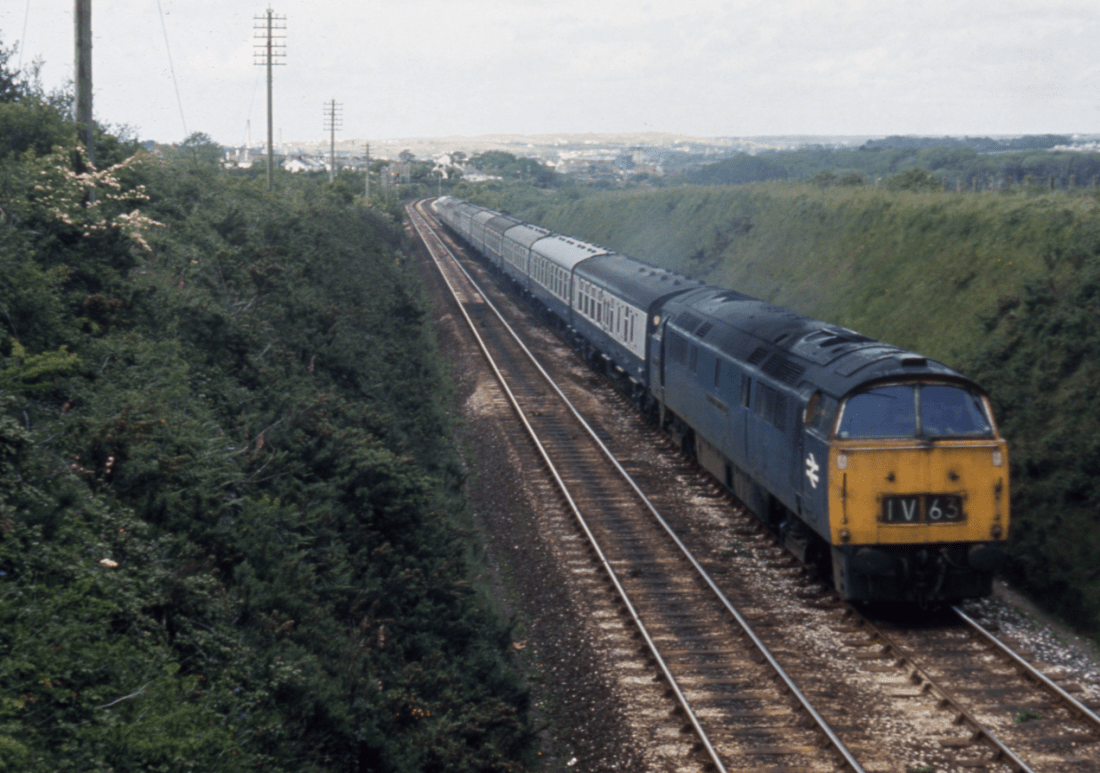
On the last stage of its run, D1055 “WESTERN ADVOCATE” climbs the bank through the cutting west of St Erth station with a passenger service on 8th June 1974. Thick gorse covers the banks with the exception of a cleared stretch on the more shaded southerly side. The town centrally in the background is Hayle and St Erth is to the right. A ‘Modern Image’ slide. 740608A02-SER-D1055-PAS_D

On the last stage of its run, D1055 “WESTERN ADVOCATE” climbs the bank through the cutting west of St Erth station with a passenger service on 8th June 1974. Thick gorse covers the banks with the exception of a cleared stretch on the more shaded southerly side. The town centrally in the background is Hayle and St Erth is to the right. A ‘Modern Image’ slide. 740608A02-SER-D1055-PAS_D
 St Erth Creamery is the backdrop to this train of milk tanks awaiting movement eastwards behind 25223, viewed from the bay platform of the station. The external appearance of the wagons belies their pristine internal cleanliness. 780619A01-SER-25223-TNK_M
St Erth Creamery is the backdrop to this train of milk tanks awaiting movement eastwards behind 25223, viewed from the bay platform of the station. The external appearance of the wagons belies their pristine internal cleanliness. 780619A01-SER-25223-TNK_M
 The rear end of a recently arrived DMU, P125, is positioned near the stop blocks at St Erth Station. It has recently left the paint shops, and has the head code neatly boxed over. Hanging baskets help to break the otherwise utilitarian ambiance. 7####DF01-SER-DMUX3-PAS_I
The rear end of a recently arrived DMU, P125, is positioned near the stop blocks at St Erth Station. It has recently left the paint shops, and has the head code neatly boxed over. Hanging baskets help to break the otherwise utilitarian ambiance. 7####DF01-SER-DMUX3-PAS_I
 The vista towards the footbridge at St Erth Station shows how little things had changed from GWR days. The British Rail corporate signs have replaced the British Railways maroon ones, which in turn had replaced those of privatisation days. 80###AD02-SER-STATN-FOOTB
The vista towards the footbridge at St Erth Station shows how little things had changed from GWR days. The British Rail corporate signs have replaced the British Railways maroon ones, which in turn had replaced those of privatisation days. 80###AD02-SER-STATN-FOOTB
 The granite walls of the building on Platform 1 of St Erth Station gleam in the sunlight of a quiet day in the 1980s, where elsewhere on the station they are still mellowed into browns. The platform edges have been emphasised with white paint on their top edge. 80###AE01-SER-STATN-VI__W
The granite walls of the building on Platform 1 of St Erth Station gleam in the sunlight of a quiet day in the 1980s, where elsewhere on the station they are still mellowed into browns. The platform edges have been emphasised with white paint on their top edge. 80###AE01-SER-STATN-VI__W
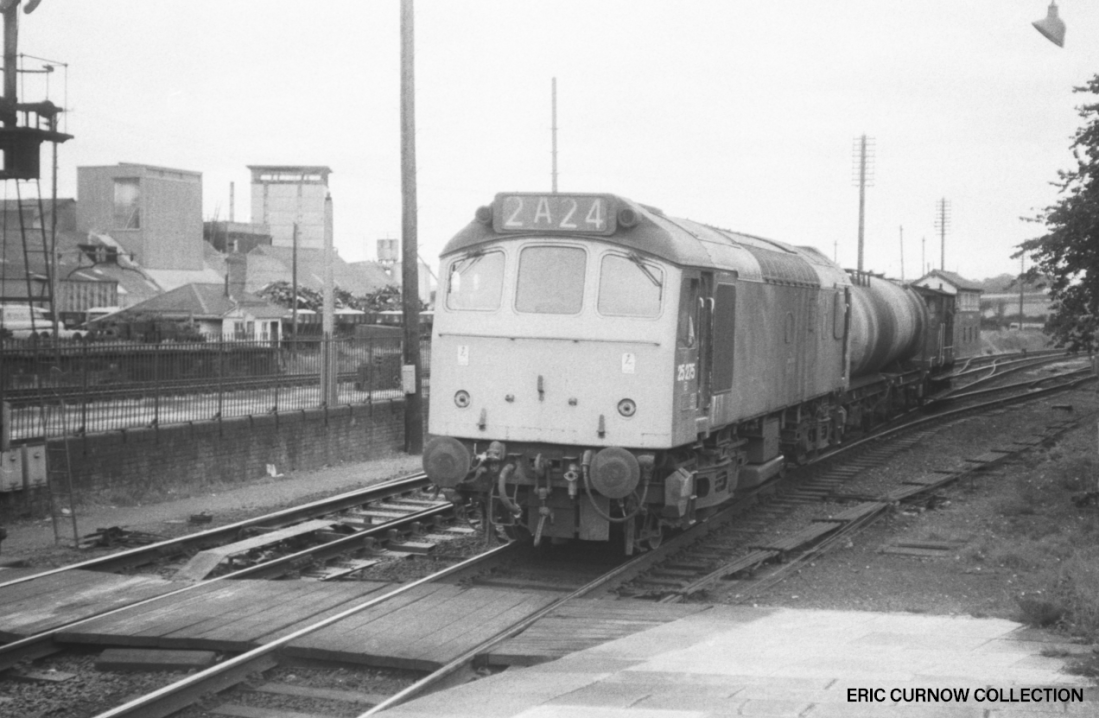
25275 crosses from the up line onto the down at the eastern end of St Erth Station with a couple of tanks and a brake van, possibly from Hayle sidings half a mile further back. The tall buildings are the Creamery, that provided milk tanks for London in a week day service, and before it a scrap merchants, plus largely redundant ancillary goods yard railway buildings. 75###AQ01-STE-25275-TNK_C
 Looking eastwards from the platform ends, agricultural buildings can be seen to the left of the signal box. By now sidings have been lifted, to the left, and a scrap merchant rents out that area. On the box’s right, the line drops towards Hayle. 861103A01-SER-S_YRD-VI__E
Looking eastwards from the platform ends, agricultural buildings can be seen to the left of the signal box. By now sidings have been lifted, to the left, and a scrap merchant rents out that area. On the box’s right, the line drops towards Hayle. 861103A01-SER-S_YRD-VI__E
 St Erth Station is seen from the A30 junction, with forecourt marked out to try to better contain parking. Double gates for loading onto the platform are closed and the phonebox has been replaced. A new station nameboard with red background has been erected. 9108#AA01-SER-S_YRD-VI-_S
St Erth Station is seen from the A30 junction, with forecourt marked out to try to better contain parking. Double gates for loading onto the platform are closed and the phonebox has been replaced. A new station nameboard with red background has been erected. 9108#AA01-SER-S_YRD-VI-_S
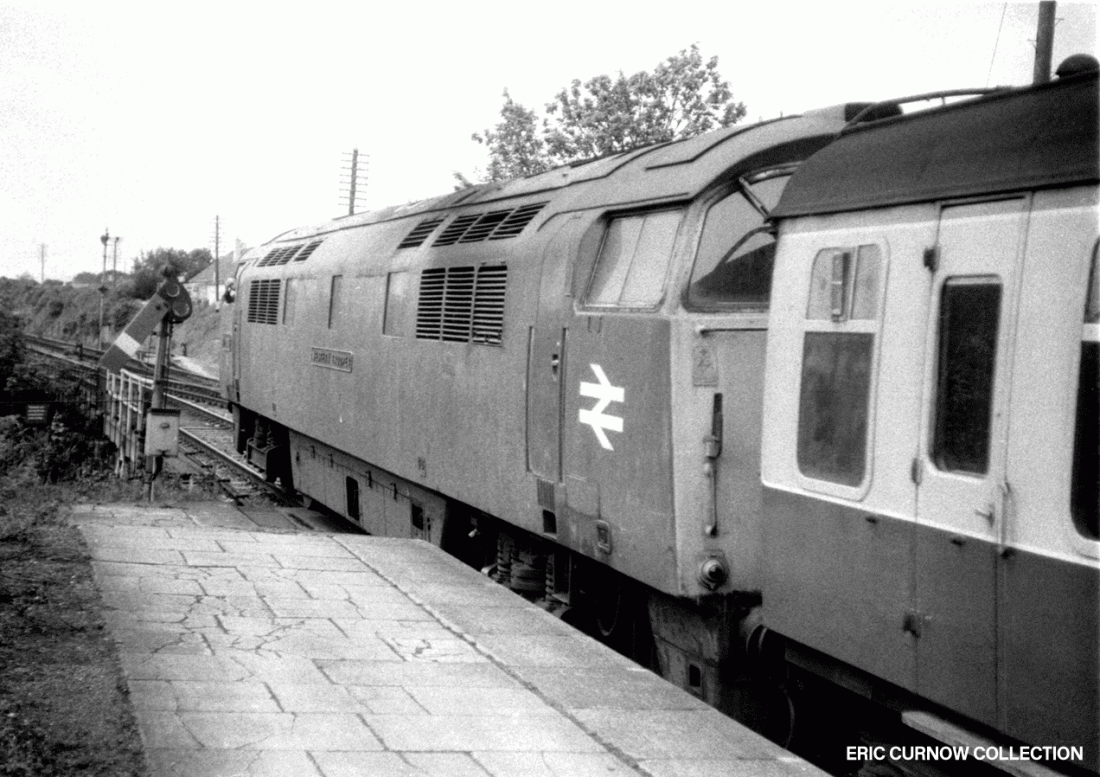
The driver of D1033 “WESTERN TROOPER” looks back St Erth Station prior to drawing away towards Penzance – the train being too long to accommodate the coaches and requiring the signal to be checked from behind. Partially hidden by the signal upright is the down siding, used to store stock when required. 7####FQ01-STE-D1062-PAS_D

Passengers hurry across the footbridge at St Erth in order to catch the soon to depart Penzance passenger service. Its near cabside logo is low to match that of the far cab that has its number above it: later economy rationalising identity to one emblem amidships was aesthetically far better. Flat bed trolleys wait with flower boxes for loading a later up service. 75###AP01-STE-500##-PAS_D

43015 in early livery leads an up service at St Erth as the main of the bracket signals at the end of the up platform gives it permission to proceed. The more distant signal is set for departure of a St Ives service, and the Signal Box can be seen just left of centre, with down refuge sidings to the right of it. Repairs to the platform surface have also been recently made. 8####BM01-SER-43015-PAS_U